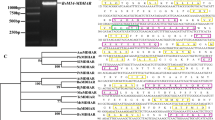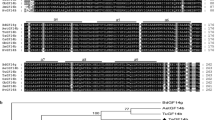Abstract
Ascorbate (AsA) is a major antioxidant and free-radical scavenger in plants. Monodehydroascorbate reductase (MDAR; EC 1.6.5.4) is crucial for AsA regeneration and essential for maintaining a reduced pool of AsA. To examine whether an overexpressed level of MDAR could minimize the deleterious effects of environmental stresses, we developed transgenic tobacco plants overexpressing Arabidopsis thaliana MDAR gene (AtMDAR1) in the cytosol. Incorporation of the transgene in the genome of tobacco plants was confirmed by PCR and Southern-blot analysis and its expression was confirmed by Northern- and Western-blot analyses. These transgenic plants exhibited up to 2.1-fold higher MDAR activity and 2.2-fold higher level of reduced AsA compared to non-transformed control plants. The transgenic plants showed enhanced stress tolerance in term of significantly higher net photosynthesis rates under ozone, salt and polyethylene glycol (PEG) stresses and greater PSII effective quantum yield under ozone and salt stresses. Furthermore, these transgenic plants exhibited significantly lower hydrogen peroxide level when tested under salt stress. These results demonstrate that an overexpressed level of MDAR properly confers enhanced tolerance against ozone, salt and PEG stress.







Similar content being viewed by others
Explore related subjects
Discover the latest articles and news from researchers in related subjects, suggested using machine learning.Abbreviations
- APX:
-
Ascorbate peroxidase
- AsA:
-
Ascorbate
- DHA:
-
Dehydroascorbate
- DHAR:
-
Dehydroascorbate reductase
- GSH:
-
Glutathione
- MDAR:
-
Monodehydroascorbate reductase
- MDHA:
-
Monodehydroascorbate
- PEG:
-
Polyethylene glycol
- ROS:
-
Reactive oxygen species
References
Adriano S, Angelo CT, Bartolomeo D, Cristos X (2005) Influence of water deficit and rewatering on the components of the ascorbate–glutathione cycle in four interspecific Prunus hybrids. Plant Sci 169:403–413
Agrawal M, Krizek DT, Argawal SB, Kramer GF, Lee EH, Mirecki RM, Rowland RA (1993) Influence of inverse day/night temperature on ozone sensitivity and selected morphological and physiological responses of cucumber. J Am Soc Hortic Sci 118:649–654
Allen RA, Webb RP, Schake SA (1997) Use of transgenic plants to study antioxidant defenses. Free Radic Biol Med 23:473–479
Asada K (1997) The role of ascorbate peroxidase and monodehydroascorbate reductase in H2O2 scavenging in plants. In: Scandalios JG (ed) Oxidative stress and the molecular biology of antioxidant defenses. Cold Spring Harbor Laboratory Press, New York, pp 715–735
Badawi GH, Kawano N, Yamauchi Y, Shimada E, Sasaki R, Kubo A, Tanaka K (2004a) Over-expression of ascorbate peroxidase in tobacco chloroplasts enhances the tolerance to salt stress and water deficit. Physiol Plant 121:131–238
Badawi GH, Yamauchi Y, Shimada E, Sasaki R, Kawano N. Tanaka K, Tanaka K (2004b) Enhanced tolerance to salt stress and water deficit by overexpressing superoxide dismutase in tobacco (Nicotiana tabacum) chloroplast. Plant Sci 166:919–928
Barnes JD, Velissariou D, Davison AW, Holevas CD (1990) Comparative ozone sensitivity of old and modern Greek cultivars of spring wheat. New Phytol 116:707–714
Barnes JD, Zheng Y, Lyons TM (2002) Plant resistance to ozone: the role of ascorbate. In: Omasa K, Saji H, Youssefian S, Kondo N (eds) Air pollution and plant biotechnology. Springer, Tokyo, pp 235–254
Borraccino G, Dipierro S, Arrigoni O (1986) Purification and properties of ascorbate free radical reductase from potato tubers. Planta 167:521–526
Bradford MM (1976) A rapid and sensitive method for the quantitation of microgram quantities of protein utilizing the principle of protein-dye binding. Anal Biochem 72: 248–254
Chen Z, Gallie DR (2005) Increasing tolerance to ozone by elevating foliar ascorbic acid confers greater protection against ozone than increasing avoidance. Plant Physiol 138:1673–1689
Chen Z, Young TE, Ling J, Chang SC, Gallie DR (2003) Increasing vitamin C content of plants through enhanced ascorbate recycling. Proc Natl Acad Sci USA 100:3525–3530
Conklin PL, Barth C (2004) Ascorbic acid, a familiar small molecule intertwined in the response of plants to ozone, pathogens and the onset of senescence. Plant Cell Environ 27:959–970
Conklin PL, Williams EH, Last RL (1996) Environmental stress sensitivity of an ascorbic acid-deficient Arabidopsis mutant. Proc Natl Acad Sci USA 93:9970–9974
Dalton DA, Langeberg L, Robbins M (1992) Purification and characterization of monodehydroascorbate reductase from soybean root nodules. Arch Biochem Biophys 292: 281–286
Dalton DA, Baird LM, Langeberg L, Taugher CY, Anyan WR, Vance CP, Sarath G (1993) Subcellular localization of oxygen defense enzymes in soybean (Glycine max [L.] Merr.) root nodules. Plant Physiol 102:481–489
De Leonardis S, De Lorenzo G, Borraccino G, Dipierro S (1995) A specific ascorbate free radical reductase isozyme participates in the regeneration of ascorbate for scavenging toxic oxygen species in potato tuber mitochondria. Plant Physiol 109:847–851
Deutsch JC (2000) Dehydroascorbic acid. J Chromatogr 88:301–309
Eltayeb AE, Kawano N, Badawi GH, Kaminaka H, Sanekata T, Morishima I, Shibahara T, Inanaga S, Tanaka K (2006) Enhanced tolerance to ozone and drought stresses in transgenic tobacco overexpressing dehydroascorbate reductase in cytosol. Physiol Plant 127:57–65
Foyer CH, Lelandais M, Kunert KJ (1994) Photooxidative stress in plants. Physiol Plant 92:696–717
Foyer CH, Lopez-Delgado H, Dat JE, Scott IM (1997) Hydrogen peroxide and Glutathione associated mechanisms of acclamatory stress tolerance and signaling. Physiol Plant 100:241–254
Frew J, Jones P, Scholes G (1983) Spectophotometric determination of hydrogen peroxide and organic hydroperoxides at low concentrations in aqueous solution. Anal Chim Acta 155:130–150
Grantz AA, Brummell DA, Bennett AB (1995) Ascorbate free radical reductase mRNA levels are induced by wounding. Plant Physiol 108:411–418
Halliwell B, Gutteridge JMC (2000) Free radicals in biology and medicine. Oxford University Press, New York
Hernández JA, Corpas FJ, Gomez M, Del Río LA, Sevilla F (1993) Salt induced oxidative stress mediated by activated oxygen species in pea leaf mitochondria. Physiol Plant 89:103–110
Horemans N, Foyer Ch, Potters G, Asard H (2000) Ascorbate function and associated transport systems in plants. Plant Physiol Biochem 38:531–540
Hossain MA, Asada K (1984) Inactivation of ascorbate peroxidase in spinach chloroplast on dark addition of hydrogen peroxide: Its protection by ascorbate. Plant Cell Physiol 25:1285–1295
Hossain MA, Asada K (1985) Monodehydroascorbate reductase from cucumber is a flavin adenine dinucleotide enzyme. J Biol Chem 260:12920–12926
Hossain MA, Nakano Y, Asada K (1984) Monodehydroascorbate reductase in spinach chloroplasts and its participation in regeneration of ascorbate for scavenging hydrogen peroxide. Plant Cell Physiol 25:385–395
Huang C, He W, Guo J, Chang X, Su P, Zhang L (2005) Increased sensitivity to salt stress in an ascorbate-deficient Arabidopsis mutant. J Exp Bot 56:3041–3049
Jiménez A, Hernández JA, del Río LA, Sevilla F (1997) Evidence for the presence of the ascorbate-glutathione cycle in mitochondria and peroxisomes of pea leaves. Plant Physiol 114:275–284
Kerk NM, Feldman LJ (1995) A biochemical model for the initiation and maintenance of the quiescent centre: implication for organization of root meristems. Development 121:2825–2833
Kwon SY, Ahn YO, Lee HS, Kwak SS (2001) Biochemical characterization of transgenic tobacco plants expressing a human dehydroascorbate reductase gene. J Biochem Mol Biol 34:316–321
Leterrier M, Corpas FJ, Barroso JB, Sandalio LM, del Río LA (2005) Peroxisomal monodehydroascorbate reductase. Clone characterization and functional analysis under environmental stress conditions. Plant Physiol 183:2111–2123
Lisenbee CS, Lingard MJ, Trelease RN (2005) Arabidopsis peroxisomes possess functionally redundant membrane and matrix isoforms of monodehydroascorbate reductase. Plant J 43:900–914
Mittler R (2002) Oxidative stress, antioxidants and stress tolerance. Trends Plant Sci 7:405–410
Mittova V, Volokita M, Guy M, Tal M (2000) Activities of SOD and the ascorbate–glutathione cycle enzymes in subcellular compartments in leaves and roots og the cultivated tomato and its wild salt-tolerant relative Lycopersicon pennellii. Physiol Plant 110:42–51
Murashige T, Skoog F (1962) A revised medium for rapid growth and bioassays with tobacco tissue cultures. Physiol Plant 15:473–497
Murthy SS, Zilinskas BA (1994) Molecular cloning and characterization of a cDNA encoding pea monodehydroascorbate reductase. J Biol Chem 269:31129–31133
Noctor G, Foyer CH (1998) Ascorbate and glutathione: keeping active oxygen under control. Annu Rev Plant Physiol Plant Mol Biol 49:249–279
Noctor G, Veljovic-Jovanivic S, Foyer CH (2000) Peroxide processing in photosynthesis: antioxidant coupling and redox signalling. Phil Trans R Soc Lond B 355:1465–1475
Pasqualini S, Batini P, Ederlina L, Porceddu A, Piccioni C, De Marchis F, Antonielli M (2001) Effects of short-term ozone fumigation on tobacco plants: response of the scavenging system and expression of the glutathione reductase. Plant Cell Environ 24:245–252
Pignocchi C, Foyer CH (2003a) Apoplastic ascorbate metabolism and its role in the regulation of cell signalling. Curr Opin Plant Biol 6:379–389
Pignocchi C, Fletcher JM, Wilkinson JE, Barnes JD, Foyer CH. (2003b) The function of ascorbate oxidase in tobacco. Plant Physiol 132:1631–1641
Plöchl M, Lyons T, Ollerenshaw J, Barnes J (2000) Simulating ozone detoxification in the leaf apoplast through the direct reaction with ascorbate. Planta 210:454–467
Runeckles VC, Chevone BI (1992) Crop responses to ozone. In: Lefohn AS (ed) Surface level ozone exposures and their effects on vegetation. Lewis, Chelsea, UK, pp 189–252
Sanmartin M, Drogoudi PA, Lyons T, Pateraki I, Barnes J, Kanellis AK (2003) Over-expression of ascorbate oxidase in the apoplast of transgenic tobacco results in altered ascorbate and glutathione redox states and increased sensitivity to ozone. Planta 216:918–928
Sano S, Tao S, Endo Y, Inaba T, Hossain MA, Miyake C, Matsuo M, Akoi H, Asada K, Saito K (2005) Purification and cDNA cloning of chloroplastic monodehydroascorbate reductase from spinach. Biosc Biotechnol Biochem 69:762–772
Sharma YK, Davis KR (1997) The effects of ozone on antioxidant responses in plants. Free Radic Biol Med 23:480–488
Smirnoff N, Wheeler GL (2000) Ascorbic acid in plants: biosynthesis and function. Crit Rev Plant Sci 19:267–290
Tanaka K, Suda Y, Kondo N, Sugahara K (1985) O3 tolerance and the ascorbate-dependent H2O2 decomposing system in chloroplasts. Plant Cell Physiol 26:1425–1431
Ushimaru T, Nakagawa T, Fujioka Y, Daicho K, Naito M, Yamuchi Y, Nonaka H, Amako K, Yamawaki K, Murata N (2005) Transgenic Arabidopsis plants expressing the rice dehydroascorbate reductase gene are resistant to salt stress. J Plant Physiol. DOI 10.1016/j.jplph.2005.10.002
Wheeler GL, Jones MA, Smirnoff N (1998) The biosynthesis pathway of vitamin C in higher plants. Nature 393:365–369
Yamamoto A, Bhuiyan NH, Waditee R, Tanaka Y, Esaka M, Oba K, Jagendorf AT, Takabe T (2005) Suppressed expression of the apoplastic ascorbate oxidase gene increases salt tolerance in tobacco and Arabidopsis plants. J Exp Bot 56:1785–1796
Yoon H, Lee H, Lee I, Kim K, Jo J (2004) Molecular cloning of monodehydroascorbate reductase gene from Brassica campestris and analysis of its mRNA level in response to oxidative stress. Biochem Biophys Acta 1658:181–186
Acknowledgments
This work was supported by the Strategic International Cooperative Program from Japan Science and Technology Agency (JST), 21st Century COE Program for Arid Land Science from Japan ministry of Education, Culture, Sports, Science and Technology (MONBUSHO) and the Core University Program from Japan Society for the Promotion of Science (JSPS).
Author information
Authors and Affiliations
Corresponding author
Rights and permissions
About this article
Cite this article
Eltayeb, A.E., Kawano, N., Badawi, G.H. et al. Overexpression of monodehydroascorbate reductase in transgenic tobacco confers enhanced tolerance to ozone, salt and polyethylene glycol stresses. Planta 225, 1255–1264 (2007). https://doi.org/10.1007/s00425-006-0417-7
Received:
Accepted:
Published:
Issue Date:
DOI: https://doi.org/10.1007/s00425-006-0417-7




